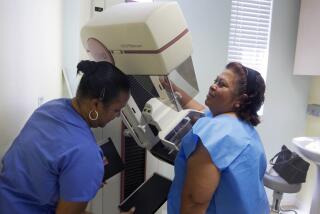Cancer still kills more black people than white. But the gap has narrowed — a lot

- Share via
Longtime cancer disparities between African Americans and whites — with blacks having a sharply higher mortality rate — have narrowed significantly over the last several years and disappeared entirely for a few age groups, according to a new study by the American Cancer Society.
African Americans still have the highest death rate and the lowest survival rate of any racial or ethnic group for most cancers. But the report noted that the overall cancer death rate had been dropping faster for blacks than for whites because of bigger declines in three of the four most common cancers — lung, prostate and colorectal.
The result: The “excess risk” of cancer death in blacks, compared with whites, fell from 47% in 1990 to 19% in 2016 for men and from 19% to 13% for women, according to the study. For men younger than 50 and women over 70, the gap has nearly closed, the study showed.
Opioids hit white areas harder; doctors there prescribe more readily, study says »
“The message is, progress has been made, but we still have a long way to go,” said Len Lichtenfeld, interim chief medical officer for the Cancer Society.
The biggest factor in narrowing the gap has been more-rapid decreases in smoking and lung cancer over the last four decades in blacks than in whites, he said.
He said that although racial disparities are critically important, gaps in cancer death rates are also caused by factors such as socioeconomic and educational status and where a person lives. Rural areas have a higher rate of lung and colorectal cancer, for instance, than urban areas.
Lichtenfeld noted that early evidence suggested the Affordable Care Act, which expanded health insurance coverage, “made a difference” in narrowing cancer disparities, but he said it was too early to know the effects of some recent changes.
The Cancer Society said that overall cancer death rates were lower in blacks than in whites during the 1950s. But the African American rate increased sharply after that, peaking in the 1990s.
Disparities developed as whites — but not blacks — benefited from gains made in improved cancer detection and treatment, Lichtenfeld said. African Americans were less likely to have insurance and access to early diagnosis. At the same time, he added, the black community was being “overwhelmingly targeted in advertising by cigarette manufacturers and the alcohol folks.”
The death rate from cancer is falling for American men, women and children of all backgrounds »
The American Cancer Society publishes information on cancer incidence, mortality and other measures every three years, using data from the National Cancer Institute, the North American Assn. of Central Cancer Registries and the National Center for Health Statistics. The report appears online in CA: A Cancer Journal for Clinicians, which is published by the society.
Laurie McGinley reports for the Washington Post






